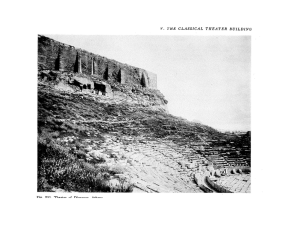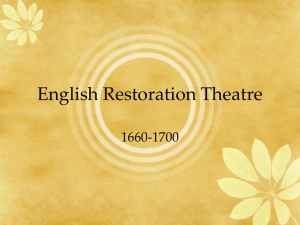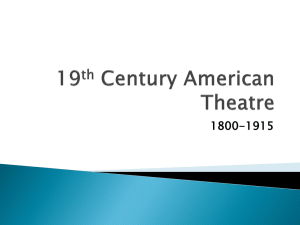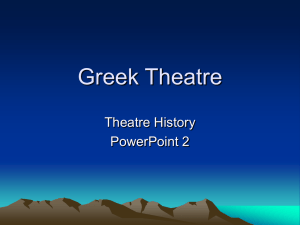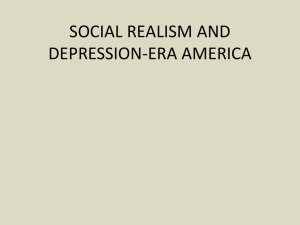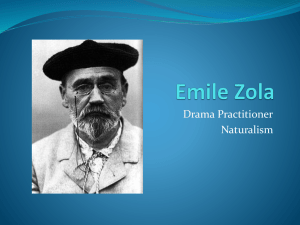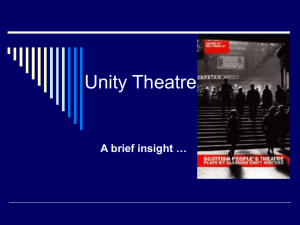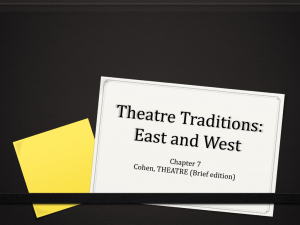The HISTORY of THEATRE
advertisement
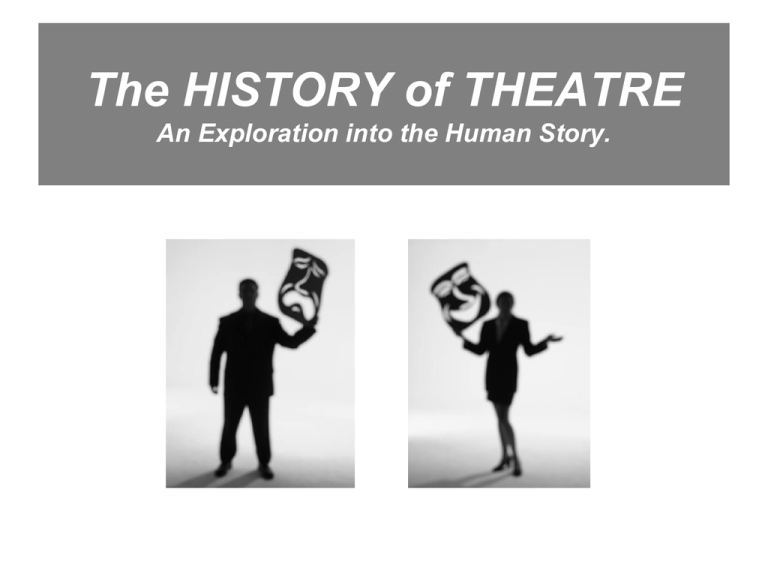
The HISTORY of THEATRE An Exploration into the Human Story. Okay…. • It’s not the WHOLE history of theatre. • Just a “quick” look at the evolution of Western Theatre. • Therefore this is not the complete story! Remember there was a lot of other theatre happening around the world. GREEK THEATRE (From 7th Century B.C.E) • Greek theatre was created to celebrate religious festivals. • A chorus was used to either sing or chant the script. • It is unknown if Thespis was a playwright, an actor or a priest, but he has been credited for creating the “first actor” who broke away from the chorus and would speak to the chorus as an individual character. This is why actors are also known as “Thespians”. • This lead to the creation of character. • Masks were used to allow the actors to play more than one character. Greek Theatre – The creation of Character The following playwrights contributed to the creation of character: • Aeschylus introduced the idea of using a second and third actor which allowed for interaction between characters. • Sophocles continued the creation of character by using the chorus less, and creating more dialogue between characters. ROMAN THEATRE (From Approximately the 4th Century B.C.E) • The Romans were greatly influenced by Greek Theatre. • The word “play” comes from the Latin word “ludus” which means recreation or play. • The Roman playwright Terence introduced the concept of a subplot allowing the audience to contrast the reactions of different characters to the same events or circumstances. • Roman Theatre was less influenced by religion than Greek theatre. ROMAN THEATRE • The audience was often loud and rude. The audience did not applaud, but rather were always shouting insults and booing. • Since the audience was so loud, much of the plays were pantomimed and repetitive. • The actors developed a code which would tell the audience about a character just by looking at them. • For example: – – – – A black wig: the character was a young man A red wig: the character was a slave. A yellow robe: the character was a woman A yellow tassel: the character was a god. Medieval European Theatre • • • • • (Approximately began in the 5th Century) After the fall of the Roman Empire, cities were abandoned, and Europe became increasingly more agricultural. After several hundred years, towns re-emerged. The Roman Catholic Church dominated religion, education and politics. It also had a strong influence on theatre. Theatre was “reborn” as “liturgical dramas” which were written in Latin and performed by priests or church members. Plots were taken from the Christian Bible. Performances also were held to celebrate religious festivals (as in Greek times) Medieval European Theatre • Later “vernacular dramas” were written in common language (therefore everyone could understand). • These plays were performed in town squares on wagon stages. • There were three types of “vernacular dramas”: • Mystery plays – based on the Old and New Testament • Miracle plays – based on the lives of the saints • Morality plays – taught a lesson through symbolic characters representing virtues or faults. Commedia Dell’Arte Italy’s Contribution (Approximately began in the 14th Century) • • • • • • • In Italy, a unique form of theatre was created for the common people – “Commedia dell’Arte”. Commedia dell’Arte required few props and no sets. The plays did not come from scripts but by “scenarios” which were an outline of a plot. The actors improvised the dialogue with comedic stunts (called lazzi). Actors wore half masks which indicated to the audience which character they were playing (Just like the Greeks). A Commedia troupe typically consisted of 10 to 12 members, a few of which were women Plays were based on stock characters, for example: • Pantalone, an elderly Venetian merchant (Mr.Burns) • Arlecchino, a servant who was a trouble maker (Bart) Renaissance and Reformation (Approximately began in the 15th Century) Italy’s Contribution • Further contributions to Theatre were made by Italians through the development of the proscenium, or “picture frame stage”. Renaissance and Reformation England’s Contribution • In England “apron stages” were used which created a more “open” stage. • Audience members surrounded the stage, and sometimes on the stage. • The emphasis in plays were on the dialogue. Plays also continued to have moralistic themes. • Later religious themes were replaced by themes of loyalty to the government. • Performers were organized into troupes or companies who developed a repertory of plays that they could perform. Renaissance and Reformation England’s Experience • In the 16th Century, England’s government swung back and forth from Catholicism to Protestantism. • Playwrights who worked to revive plays written in Latin, were believed to be supporting the Catholic Church. • Playwrights who worked to revive Greek plays were associated with Protestantism. • Depending on who was in power at the time, a playwright could be put to death for reviving the “wrong” play. • Many playwrights began to avoid the revival of classic work, and wrote non-political and nonreligious plays. Renaissance and Reformation Theatre is Threatened • The political problems in England at the time made theatre “dangerous”. • Civil unrest could be inspired by performances. • Theatres were also associated with the temptation to spend time watching performances instead of working. • Theatres were also associated with prostitution since prostitutes would be in the area where plays were performed, and sometimes were even in the audience. • Added to the political problems, fear of the plague closed theatres. • These conditions lead to the licensing of acting companies which lead to more control of theatre by the state. Elizabethan Theatre (16th Century) A Theatre “God” is Born • William Shakespeare is the most notorious playwright in the history of theatre. • During this time period, there are other notable playwrights including: Christopher Marlowe and Ben Jonson. • Shakespeare and his contemporaries encouraged a more natural style of speaking and acting. They also explored the theme of “good government”. • Shakespeare’s characters were also more “human” with both positive and negative aspects of their character being explored. • During this time, plays were still presented in open-air theatres or at times, presented at court. The Republic and The Restoration (Approximately began in the 17th Century) France’s Contribution to Theatre • • • • • • In 1642, the English Parliament closed all the theatres in England. Many English actors fled to France. Theatre in France began to focus on scenery and creating spectacle. Plays now included costume, dance and clever scenery which also required scene changes. These aspects of theatre were more emphasized than acting or the plot. Theatres also used the proscenium style of stage, where the acting took place on the forestage and the stage behind the proscenium was used to display the scenery. The French also allowed women to perform on stage. (When Theatre returned to England in 1660, women were allowed on stage there too. This is due to the French influence). 18th Century Theatre • In the 18th Century, Theatre became a popular pastime. • During the first half of the 18th century, actors assumed poses and performed their lines in a “sing-song” manner. • Actors dressed in modern fashionable clothes. • There was a rivalry between actresses as to who would wear the finest dress. • Pantomime was still popular and promoted the development of spectacular staging, slapstick and special effects. 18th Century Theatre David Garrick • • • • • • Garrick is one of Britain’s greatest actors and the first to be called a star. From 1741 until his retirement in 1776, he was a highly successful actor, producer and theatre manager. He wrote more than 20 plays, and adapted many more (including plays by Shakespeare) Garrick emphasized a more natural form of speaking and acting that mimicked life. This form of acting inspired the movement towards realism and naturalism in theatre. Garrick “banished” the audience from the stage, and actors now performed among the furnishings and scenery. Plays began to be written about ordinary people. This could also explain why theatre and become more commercial, since it could reach a wider audience. 19th Century Theatre Lighting and Stage Advancements • The Industrial Revolution of the 19th Century changed theatre as well. • Gas lighting was first introduced in 1817 in London’s Drury Lane Theatre. • By the end of the century, electrical lighting made its appearance on stage. • Elaborate mechanisms for changing scenery were developed, including fly-lofts, elevators, and revolving stages. 19th Century Theatre Melodrama • • • • • • • • The poor quality of lighting and the advances in set design lead to a theatre style which emphasized action and spectacle and not acting. Melodrama was created. Comes from "music drama" – music was used to increase emotions or to signify characters . Actors performed their characters using gestures and body poses to demonstrate their characters. A simplified moral universe; good and evil are embodied in stock characters. Many special effects were part of the performance: fires, explosions, and or earthquakes. Traditional form: the villain poses a threat, the hero or heroine escapes, etc, ends with a happy ending. During the first half of the century, playwrights were poorly paid. 19th Century Theatre “The Era of Theatre Greats” • In the later half of the 19th Century, 3 incredible playwrights changed theatre. • Their work began the movement of “realism” (which was to bring “real life on stage”) • It would be as if the audience was watching through a “fourth wall” spying on these characters. • These amazing playwrights were: • Henrik Ibsen, who wrote in Norwegian • George Bernard Shaw, who wrote in English • Anton Chekhov, who wrote in Russian 19th Century Theatre The Greatest of All • The serious and realistic drama that was being created in the second half of the 19th century challenged actors to learn a new method of acting. • Konstantin Stanislavski wrote several works on the art of acting, such as “An Actor Prepares”. • Stanislavski’s method of acting is still used today and is considered to be the best training for actors. • The following actors have studied Stanislavski’s methods: Jack Nicholson, James Dean, Marlon Brando, Robert DeNiro, Al Pacino, Benicio Del Toro, and Johnny Depp. (And many more). 20th Century Theatre – Modern Theatre (Finally) • During the 20th Century, the world changed forever (2 world wars, and much social and political upheaval). • The Realism movement in theatre. and the creation a more naturalistic acting style continued to flourish in the 20th Century. • Many other Theatre movements also began; one such theatre style was Theatre of the Absurd. • Theatre of the Absurd, which grew out of the post-modern movement which believed that life has no meaning, and there is no God. • This style of Theatre grew out of Europe in the late 1940’s. The End…? • Believe it or not, there was a lot of Theatre History that was not included (i.e Musical Theatre, Theatre of the Oppressed, Improv Theatre, Children’s Theatre, Cabaret, Vaudeville, Street Theatre, Mime…etc, etc, ETC! Not to mention theatre that was happening in other parts of the world. • The craft of acting and of theatre is constantly changing in reaction to audiences’ tastes, political and social movements, and advances in technology. Final Thought Oscar Wilde said it best: • “I regard the theatre as the greatest of all art forms, the most immediate way in which a human being can share with another the sense of what it is to be a human being”.
